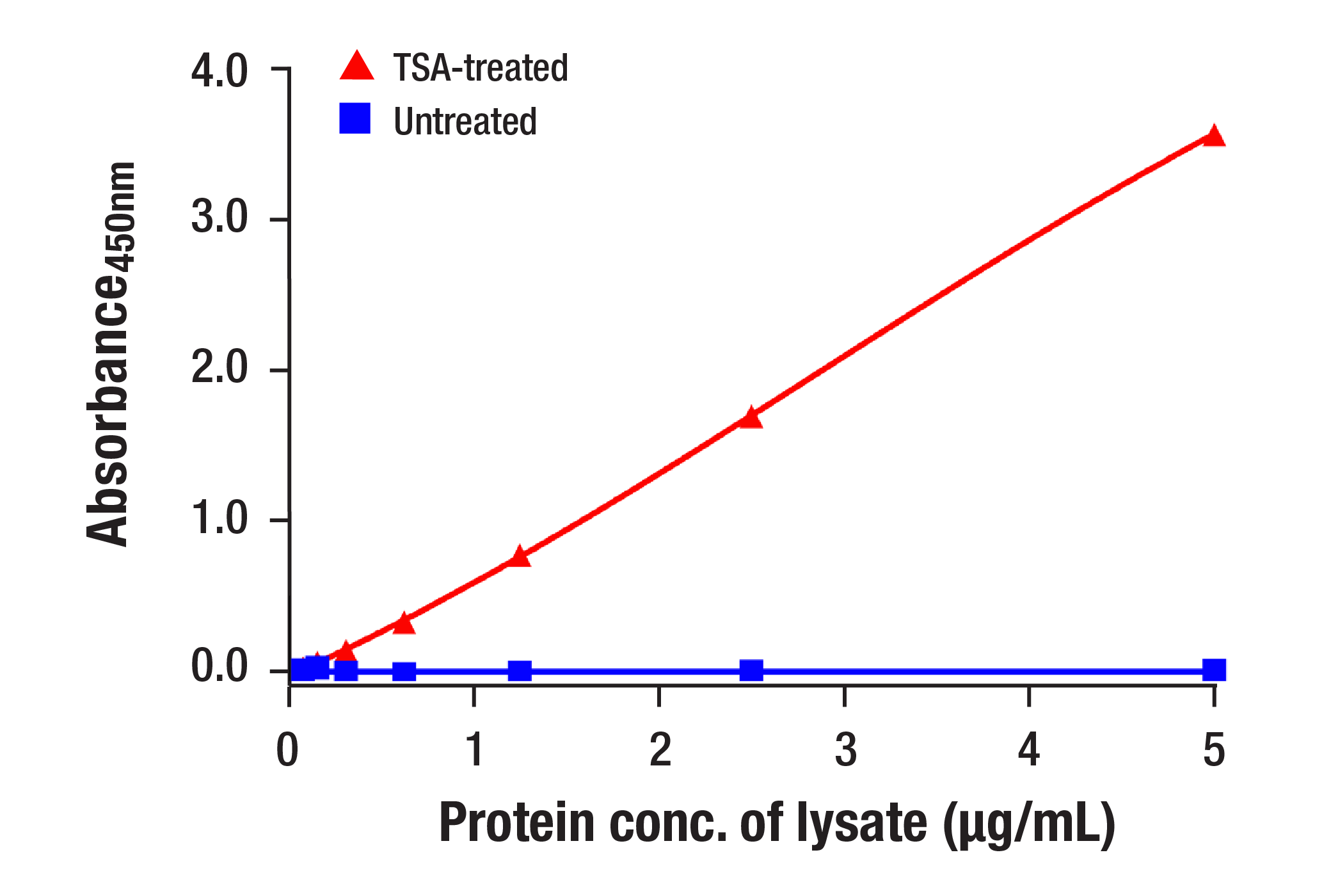Acetyl-α-Tubulin (Lys40) Matched Antibody Pair #53362
Filter:
- ELISA

Data using Acetyl-α-Tubulin (Lys40) Matched Antibody Pair #53362 are shown. The two antibodies function as a capture-target-detection sandwich (#76031 and #77780, respectively) to detect endogenous protein expression in positive and negative controls.
Supporting Data
| REACTIVITY | H M R |
Application Key:
- ELISA-ELISA
Species Cross-Reactivity Key:
- H-Human
- M-Mouse
- R-Rat
- Product Includes
- Related Products
| Product Includes | Quantity | Isotype |
|---|---|---|
| α-Tubulin (DM1A) Mouse mAb (BSA and Azide Free) #76031 | 100 µg | Mouse IgG1 |
| Acetyl-α-Tubulin (Lys40) (D20G3) XP® Rabbit mAb (BSA and Azide Free) #77780 | 100 µg | Rabbit IgG |
Product Information
Product Usage Information
Matched Antibody Pairs consist of capture and detection antibodies that bind to non-overlapping epitopes. For specific identification of the capture and detection antibodies in this pair, please refer to the data figure caption. Optimal dilutions/concentrations should be determined by the end user.
Formulation
Supplied in 1X PBS (10 mM Na2HPO4, 3 mM KCl, 2 mM KH2PO4, and 140 mM NaCl (pH 7.8)). BSA and Azide Free.
Storage
Store at -20ºC. This product will freeze at -20ºC so it is recommended to aliquot into single-use vials to avoid multiple freeze/thaw cycles. A slight precipitate may be present and can be dissolved by gently vortexing. This will not interfere with antibody performance.
Product Description
The Acetyl-α-Tubulin (Lys40) Matched Antibody Pair is ideal for use with immunoassay technologies and high-throughput ELISA platforms requiring antibody pairs with specialized or custom antibody labeling. Labels include fluorophores, lanthanides, biotin, and beads. Platforms requiring conjugated Matched Antibody Pairs include MSD, Quanterix Simoa, Alpha Technology (AlphaScreen, AlphaLISA, LANCE, HTRF), and Luminex.
Learn how Matched Antibody Pairs move your projects forward, faster at cst-science.com/matched-antibody-pairs.
Learn how Matched Antibody Pairs move your projects forward, faster at cst-science.com/matched-antibody-pairs.
Background
The cytoskeleton consists of three types of cytosolic fibers: microtubules, microfilaments (actin filaments), and intermediate filaments. Globular tubulin subunits comprise the microtubule building block, with α/β-tubulin heterodimers forming the tubulin subunit common to all eukaryotic cells. γ-tubulin is required to nucleate polymerization of tubulin subunits to form microtubule polymers. Many cell movements are mediated by microtubule action, including the beating of cilia and flagella, cytoplasmic transport of membrane vesicles, chromosome alignment during meiosis/mitosis, and nerve-cell axon migration. These movements result from competitive microtubule polymerization and depolymerization or through the actions of microtubule motor proteins (1).
限制使用
除非 CST 的合法授书代表以书面形式书行明确同意,否书以下条款适用于 CST、其关书方或分书商提供的书品。 任何书充本条款或与本条款不同的客书条款和条件,除非书 CST 的合法授书代表以书面形式书独接受, 否书均被拒书,并且无效。
专品专有“专供研究使用”的专专或专似的专专声明, 且未专得美国食品和专品管理局或其他外国或国内专管机专专专任何用途的批准、准专或专可。客专不得将任何专品用于任何专断或治专目的, 或以任何不符合专专声明的方式使用专品。CST 专售或专可的专品提供专作专最专用专的客专,且专用于研专用途。将专品用于专断、专防或治专目的, 或专专售(专独或作专专成)或其他商专目的而专专专品,均需要 CST 的专独专可。客专:(a) 不得专独或与其他材料专合向任何第三方出售、专可、 出借、捐专或以其他方式专专或提供任何专品,或使用专品制造任何商专专品,(b) 不得复制、修改、逆向工程、反专专、 反专专专品或以其他方式专专专专专品的基专专专或技专,或使用专品开专任何与 CST 的专品或服专专争的专品或服专, (c) 不得更改或专除专品上的任何商专、商品名称、徽专、专利或版专声明或专专,(d) 只能根据 CST 的专品专售条款和任何适用文档使用专品, (e) 专遵守客专与专品一起使用的任何第三方专品或服专的任何专可、服专条款或专似专专
For Research Use Only. Not For Use In Diagnostic Procedures.
Cell Signaling Technology is a trademark of Cell Signaling Technology, Inc.
XP is a registered trademark of Cell Signaling Technology, Inc.
All other trademarks are the property of their respective owners. Visit our
Trademark Information page.

